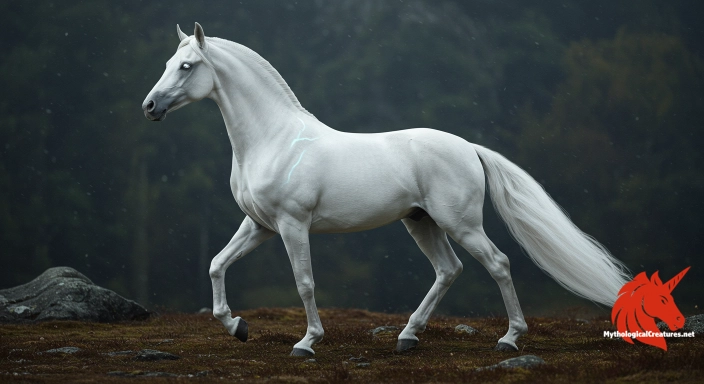Empusa: Empusa is a shape-shifting spectral demon from Greek mythology, famed for her single copper leg and seductive allure.

Empusa
Empusa - Empusa serves as a cautionary figure representing the dangers of succumbing to seductive and deceptive supernatural forces.
Origins & First Encounters
Empusa is a beguiling and enigmatic figure whose origins are rooted deep within ancient Greek myth, emerging as a symbol of both seduction and terror. Born from the intertwining of folklore and the shadowy domains of Hecate, she encapsulates the paradox of divine beauty and monstrous otherness. Her earliest attestations, though fragmentary, hint at a being designed to embody the fears of the night and the unpredictable power of transformation. Over time, her mythos was enriched through oral traditions and literary fragments, reflecting the collective anxieties of a people who grappled with the unknown. She is portrayed as a shape-shifter, seamlessly transitioning between forms that range from irresistibly alluring to grotesquely abhorrent. The cultural context of her emergence is intertwined with the rituals of liminality and the mysteries of the underworld. Celebrated and feared in equal measure, Empusa became a personification of the capricious forces of nature and desire. In her contradictions, she challenges the boundaries between the mortal and the divine, ensuring her place as one of myth’s most compelling enigmas.
Source Texts & Tale Variants
Ancient literary sources offer glimpses into the character of Empusa, though details vary widely between fragments and later interpretations. In Hellenistic magical papyri and scattered references from Late Antiquity, she is depicted as a spectral entity whose shifting guise is as captivating as it is dangerous. Some accounts cast her directly under the command of Hecate, aligning her with nocturnal rites and the mysticism of crossroads. Later mythographers interwove her narrative with that of lamiai and other vampiric figures, creating a composite image that reflects both fear and fascination. Various texts relay her seductive exploits, emphasising her role in preying upon unsuspecting young men through beguiling transformations. In lesser-known regional folktales, subtle nuances in her character shift the focus from simple malevolence to a more complex moral ambiguity. Despite the patchy nature of the surviving literature, these primary sources have inspired a rich tapestry of story variants that explore her dual nature. The multiplicity of accounts highlights a deliberate mystery, inviting reinterpretation and debate over her true function within myth.
Form & Powers
The physical depiction of Empusa is as mutable as the myths themselves, endowed with features that both mesmerise and repulse. Most strikingly, she is said to possess a single copper leg which gleams unnaturally under the moonlight, a detail that underscores her supernatural origin. This metallic appendage, often described as a heavy, molten limb, stands in stark contrast to her otherwise fluid and alluring form. In some renditions, her appearance morphs to include other bizarre attributes such as cloven hooves or serpentine eyes that burn with an eerie luminescence. Her visage is frequently portrayed as a blend of traditional feminine beauty with unsettling, almost inhuman traits, a duality that captures the essence of her character. The rapid shifts in her appearance—from a temptress to a ghastly spectre—serve to reinforce her role as a chameleon of the night. Artistic imaginings have added layers of complexity, often depicting her with wild, flowing hair and an ever-shifting gaze that reflects hidden terrors. Variations in descriptive detail across sources only serve to heighten the mystery of her form, leaving her physical essence a canvas for both horror and allure. Her mutable nature makes her an enduring subject for reinterpretation in both ancient art and modern visual culture.
Regional Faces
Across the diverse tapestry of ancient Greek regional lore, Empusa emerges in a rich variety of forms and interpretations. In parts of mainland Greece, she is interwoven with local tales of nocturnal spectres and shape-shifters who roam the rural expanses, serving as a cautionary figure for those who wander after dark. In island traditions, particularly within the Aegean, her portrayal often merges with native legends of captivating seductresses, thereby broadening her mythic resonance. Regions such as Thessaly and Macedonia present her as a hybrid entity, combining elements of divine retribution with natural phenomena, reflecting local beliefs about the interplay between fate and magic. In some adaptations, details like her single metallic leg are amplified to evoke a sense of otherworldly machinery and relentless pursuit. Other locales soften her terrifying aspects to highlight her enigmatic beauty and tragic inevitability in the cycle of night and desire. Local storytellers adapted her narrative to serve contemporary moral and societal lessons, often using her as a symbol for the dangers of unbridled temptation. Despite these variations, a common thread remains in her identity—a figure that embodies the simultaneous allure and menace of the supernatural. Each regional variant adds a layer of cultural specificity while preserving the core themes inherent to her myth.
Cultural Parallels
Empusa occupies a fascinating position in the broader context of mythological beings, sharing striking parallels with figures from diverse cultural traditions. Her seductive yet dangerous nature resonates with the archetype of the succubus found in medieval European folklore, where supernatural seduction is similarly wrought with peril. She is often compared to the lamia, another Greek mythological figure, with both entities blurring the line between enchantress and monster. In Eastern traditions, echoes of her tale can be seen in the vampiric legends of nocturnal predators whose beauty conceals a fierce hunger. Moreover, her shape-shifting ability finds a kinship with other regional tricksters and spirit entities that defy fixed identity. Such comparative analysis reveals a universal theme: the fear and allure of beings that exist beyond the natural order, drawing parallels between moral warnings and the mystery of desire. These cross-cultural connections underscore a common human preoccupation with duality as personified by the merging of beauty with dark, uncontrollable forces. As myth and legend travel across time and space, Empusa’s qualities mirror those of similar enchantresses whose narratives caution against the deceptive nature of irresistible charm. Thus, her story becomes a focal point for understanding how diverse cultures navigate the complexities of temptation, danger, and transformation.
Legacy & Modern Evolution
The myth of Empusa has witnessed a remarkable evolution from an ominous night-haunt to a complex symbol in modern storytelling. Her early portrayals as a menacing seductress under Hecate’s command have gradually broadened, incorporating themes of empowerment and metamorphosis in contemporary narratives. Over the centuries, she has transitioned from strictly a cautionary figure in folklore to an icon within the realms of fantasy and horror literature. The Gothic and Romantic periods reimagined her as a tragic figure of irresistible allure, a harbinger of both desire and demise. Modern reinterpretations often cast her in roles that explore the fluidity of identity, blurring boundaries between villainy and victimhood. In films, novels, and even video games, Empusa's legacy is frequently invoked to represent a dark, potent femininity that captivates while it terrifies. Her image serves as a rich metaphor for the perils and powers inherent in transformation and the night’s mystique. Contemporary artistic renditions continue to play with her dual nature, highlighting the ongoing cultural fascination with entities that defy easy categorisation. Ultimately, Empusa endures as a potent symbol, her legacy weaving through both ancient myth and modern imagination, a testament to the timeless interplay between beauty and the uncanny.
Interesting Fact
Empusa's single copper leg is a unique and striking feature, symbolising her liminal status between the physical and the spectral realms.
Quick Creature Info
Origin:
Our Mythic Legendary Rating:

Also Sometimes Known As:
Habitat:
Supernatural Powers:
Physical Attributes:
Abilities:
Behavior:
Lore:
Related Creatures, Tales or Lore
- LLamia
- MMormolykeia
References
Discover Another Mythical Legend You May Not Have Heard Of?
Uncover the mysteries of ancient folklore and expand your knowledge of legendary beings from cultures around the world.
Dare to Meet the Glaðr....
Curated by the Mythological Creatures Team (rev. May 2025)
